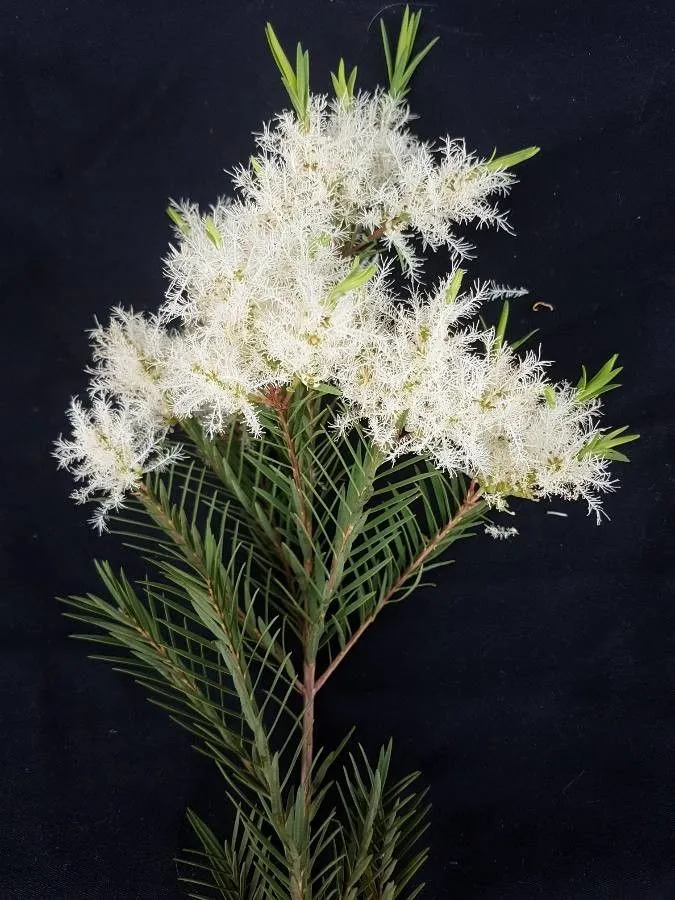
Author: Sm.
Bibliography: Trans. Linn. Soc. London 3: 278 (1797)
Year: 1797
Status: accepted
Rank: species
Genus: Melaleuca
Vegetable: Unknown
Observations: E. Australia
The Narrow-leaf paperbark, scientifically known as Melaleuca linariifolia, is a remarkable species belonging to the Myrtaceae family. This plant is characterized by its distinctive narrow leaves and its unique, papery bark, which peels away in thin, delicate layers. Native to Eastern Australia, it thrives in various environmental conditions, showcasing its adaptability and resilience.
This species was first described by the esteemed botanist James Edward Smith, and its botanical reference can be traced back to a publication in the Transactions of the Linnean Society of London, where it was meticulously documented in 1797.
The Narrow-leaf paperbark typically forms a dense, bushy tree reaching heights of up to 10 meters, though it can sometimes grow taller under optimal conditions. The foliage is comprised of soft, linear leaves that give the plant its common name. These leaves are a vibrant green, offering a striking contrast to the white or cream-colored flowers that bloom in large, fluffy clusters during its flowering season. These flowers not only add an aesthetic appeal but also attract a plethora of pollinators including bees and butterflies, playing a vital role in the local ecosystem.
One of the most fascinating attributes of the Melaleuca linariifolia is its bark. The bark is layered and paper-like, shedding in thin strips which provide an intriguing texture and visual interest. This peeling bark is not only a distinctive feature but also serves a protective function, helping the tree conserve moisture and shield against environmental stresses.
In terms of cultivation, the Narrow-leaf paperbark is fairly low maintenance. It prefers well-drained soils and can tolerate both full sun and partial shade. This plant is a versatile addition to gardens, parks, and restoration projects, particularly in regions that mimic its native Australian habitat. Its ability to withstand drought and poor soil conditions makes it a hardy choice for sustainable landscaping.
Additionally, Melaleuca linariifolia has been utilized in traditional practices by Indigenous Australians, who have long valued the plant for its medicinal properties and practical uses. The essential oils derived from its leaves are known for their antibacterial and antifungal benefits, making them valuable in natural remedies and skincare products.
In summary, the Narrow-leaf paperbark is a versatile, resilient, and visually appealing plant that not only enhances the aesthetic quality of any landscape but also supports biodiversity and offers practical benefits. The historical context and botanical significance as documented by Smith further underscore its importance in the botanical world.
Eng: cajeput tree, flax-leaf paperbark, narrow-leaf paperbark, narrow-leaf teatree, snow-in-summer
Por: floco-de-neve, melaleuca, nuvem-branca
En: Narrow-leaf paperbark, Snow-in-summer, Flax-leaf paperbark, Narrow-leaf teatree, Cajeput tree
Zh: 柳穿鱼叶白千层
Pt: Floco-de-neve, Melaleuca, Nuvem-branca
Zh-tw: 柳穿魚葉白千层
Taken Dec 27, 2021 by Matthew Brown (cc-by-sa)
Taken Jul 30, 2012 by EOL − Zoya Akulova (cc-by-nc)
Taken Aug 9, 2022 by Vincent Luczkow (cc-by-sa)
Taken Dec 19, 2020 by sonet fraser (cc-by-sa)
Taken Dec 10, 2021 by flower_knight (cc-by-sa)
Taken Oct 7, 2021 by Vinicius Castro Souza (cc-by-sa)
Taken Oct 14, 2020 by Giorgio Jetson (cc-by-sa)
Taken Sep 5, 2021 by Kate Sturges (cc-by-sa)
Taken Dec 28, 2020 by Makoto Makoto (cc-by-sa)
Taken Dec 10, 2021 by flower_knight (cc-by-sa)
Taken Nov 21, 2021 by Amit Dhiman (cc-by-sa)
Taken Apr 30, 2021 by Pereira Jorge (cc-by-sa)
Taken Jun 1, 2022 by Hannah Nice (cc-by-sa)
Taken Nov 12, 2022 by ian connop (cc-by-sa)
Taken Jul 30, 2012 by EOL − Zoya Akulova (cc-by-nc)
Taken Jul 30, 2012 by EOL − Zoya Akulova (cc-by-nc)
Taken Aug 23, 2020 by centurión matias (cc-by-sa)
Taken Jun 13, 2020 by Jayalaxmi Hidangmayum (cc-by-sa)
Taken Dec 2, 2021 by Jenna O’Brien (cc-by-sa)
Taken Feb 9, 2022 by Alex P. Albuquerque (cc-by-sa)
Taken Sep 23, 2021 by Patit Austria (cc-by-sa)
Family: Myrtaceae Author: (F.Muell.) K.D.Hill & L.A.S.Johnson Bibliography: Telopea 6: 402 (1995) Year: 1995 Status:…
Family: Rubiaceae Author: Pierre ex A.Froehner Bibliography: Notizbl. Bot. Gart. Berlin-Dahlem 1: 237 (1897) Year:…
Family: Sapindaceae Author: Koidz. Bibliography: J. Coll. Sci. Imp. Univ. Tokyo 32(1): 38 (1911) Year:…
Family: Asteraceae Author: A.Gray Bibliography: Pacif. Railr. Rep.: 107 (1857) Year: 1857 Status: accepted Rank:…
Family: Fabaceae Author: Medik. Bibliography: Vorles. Churpfälz. Phys.-Ökon. Ges. 2: 398 (1787) Year: 1787 Status:…
Family: Aspleniaceae Author: (Cav.) Alston Bibliography: Bull. Misc. Inform. Kew 1932: 309 (1932) Year: 1932…